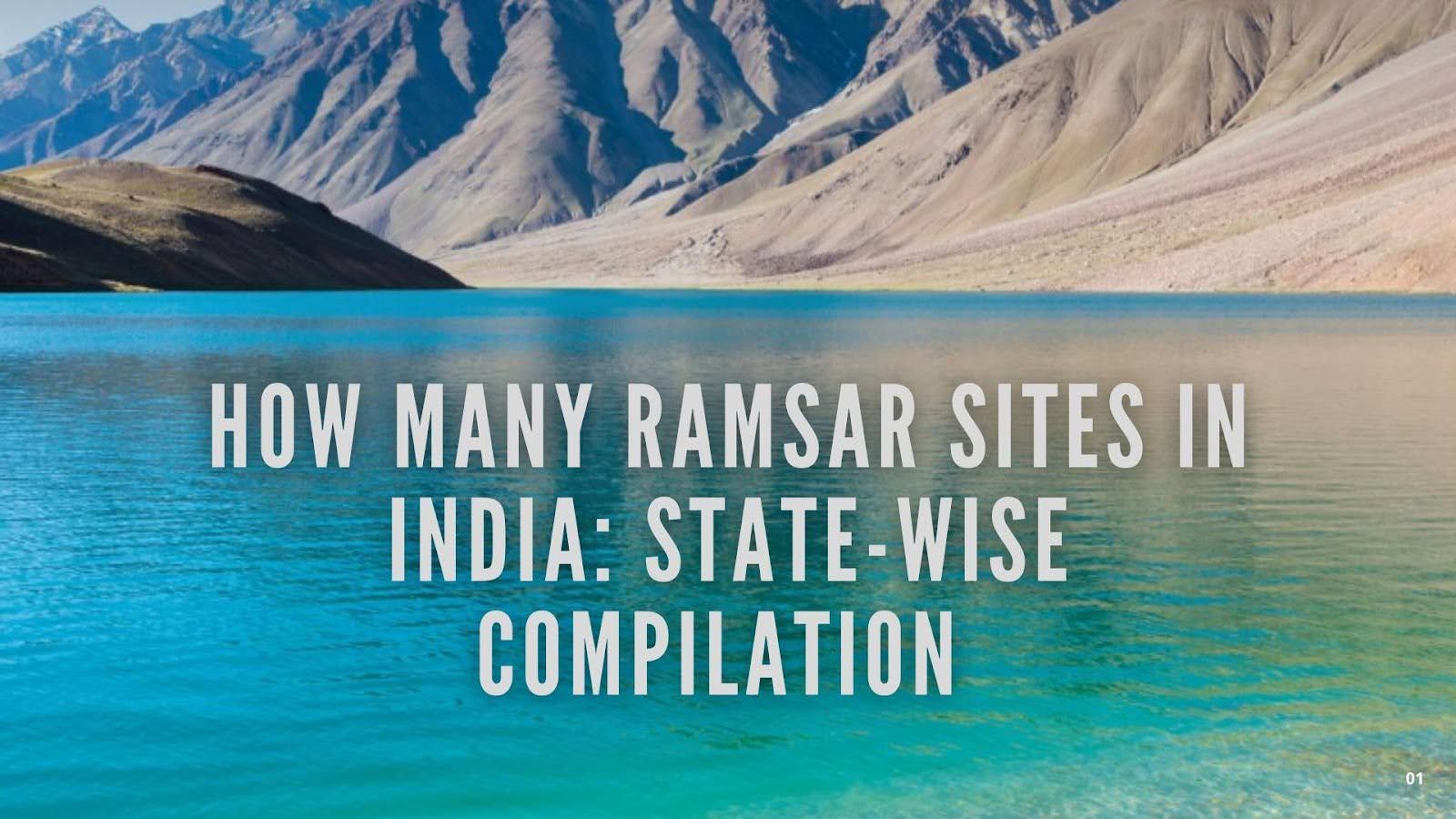State-wise and Area-wise List of Ramsar Sites in India
Mar, 2025
•4 min read
Did you know that India, with its vast ecological diversity, is home to an impressive number of Ramsar sites? How many Ramsar sites in India are there, and why are they so critical for both biodiversity and sustainable development? These wetlands are not just havens for wildlife but also play a pivotal role in protecting livelihoods and mitigating climate change. For UPSC aspirants, understanding Ramsar sites is key to answering questions on environment, geography, and international conservation efforts.
This blog provides a detailed state-wise and area-wise breakdown of India’s Ramsar sites. Let’s explore these wetlands to help you score high in your exam!
What are Ramsar Sites?

Ramsar Sites are wetlands of international importance designated under the Ramsar Convention, an intergovernmental treaty signed in 1971 in the Iranian city of Ramsar. The primary aim of this convention is to conserve and sustainably use wetlands, recognizing their critical role in supporting biodiversity, maintaining water cycles, and providing essential ecosystem services such as flood control, water purification, and carbon storage.
Wetlands classified as Ramsar Sites are recognized for their ecological significance on a global scale. These can include lakes, rivers, marshes, mangroves, peatlands, coral reefs, and even man-made sites such as reservoirs and rice paddies.
Role of Ramsar Sites in Biodiversity Conservation and Sustainable Development
Wetlands are called the "kidneys of the Earth" due to their unmatched ability to sustain ecosystems, regulate water cycles, and support human livelihoods. Ramsar Sites, in particular, play a pivotal role in preserving biodiversity and promoting sustainable practices globally. For India, which is home to a rich and diverse array of wetland ecosystems, Ramsar Sites are indispensable for ecological balance and environmental security.
Here are the key reasons why Ramsar Sites are crucial for biodiversity conservation and sustainable development:
- Protection of Endangered Species: Ramsar Sites provide habitats for numerous threatened and endangered species, acting as safe havens for biodiversity that is under threat from habitat loss and climate change.
- Ecosystem Services: Wetlands offer critical services, such as groundwater recharge, water filtration, and flood control, which are essential for maintaining ecological balance and supporting agriculture.
- Carbon Sequestration: Many wetlands, such as peatlands and mangroves, act as significant carbon sinks. They help mitigate the effects of climate change by reducing greenhouse gases in the atmosphere.
- Support for Livelihoods: Wetlands sustain millions of people by supporting fishing, agriculture, and ecotourism, making them vital for the socioeconomic well-being of communities.
- Waterbird Habitat: Ramsar Sites serve as breeding and feeding grounds for migratory birds, many of which travel thousands of kilometers. These wetlands play a vital role in maintaining the global bird population and supporting avian biodiversity.
- Cultural and Educational Significance: Many Ramsar Sites hold cultural, spiritual, and educational importance, fostering a deeper connection between people and nature and raising awareness about conservation.
- Climate Regulation: By controlling water flows, preventing soil erosion, and maintaining local climates, Ramsar wetlands contribute to environmental stability and climate resilience.
Also see: Ecosystem & Biodiversity | Environment and Ecology | GS Foundation Initiative for UPSC
Understanding the multifaceted benefits of Ramsar Sites is essential as it connects topics in geography, environment, and international agreements, making it a vital part of your preparation strategy.
Want to practice unlimited MCQs and track your progress? With SuperKalam’s MCQ practice, you can tackle questions from past papers and assess your performance.
Criteria for the Designation of Ramsar Sites
The Ramsar Convention uses nine specific criteria to identify wetlands of international importance, based on their ecological, biological, and cultural significance. Familiarity with these criteria can help aspirants answer questions about wetland conservation in India and globally.
Ramsar Site Designation Criteria
- Rare or Unique Wetland Types: The site represents a rare, unique, or exemplary wetland type within its biogeographic region.
Example: Chilika Lake in Odisha is a unique coastal lagoon that supports a variety of species. - Supports Threatened Species: The wetland provides habitat for vulnerable, endangered, or critically endangered species.
Example: Sundarban Wetland supports the critically endangered Bengal tiger. - Supports Biodiversity: It supports plant and animal species critical to maintaining biodiversity.
Example: Loktak Lake in Manipur is home to the endangered Sangai deer. - Fish Spawning Grounds: The site is essential for fish species during critical life stages like spawning, migration, and nursery grounds.
Example: Bhitarkanika Mangroves in Odisha are a breeding ground for saltwater crocodiles and other aquatic species. - Supports Waterbirds: The wetland regularly hosts significant populations of waterbirds, including migratory species.
Example: Keoladeo National Park in Rajasthan is a renowned avian sanctuary for migratory birds. - Supports Migratory Species: The site is a critical stopover or wintering area for migratory species.
Example: Pong Dam Lake in Himachal Pradesh is a wintering site for migratory waterfowl. - Important for Indigenous Species: It supports species important for ecological or economic reasons in their natural habitats.
Example: Vembanad-Kol Wetland in Kerala sustains local fish species critical to livelihoods. - Natural Water Regulation: Wetlands that regulate water cycles and maintain hydrological functions.
Example: Ashtamudi Lake in Kerala supports groundwater recharge and flood control. - Cultural and Religious Significance: Wetlands that hold cultural, historical, or religious importance.
Example: Renuka Wetland in Himachal Pradesh is revered for its religious significance.
Must Watch: Utilise This 5-Day Plan To Revise Environment and Ecology for UPSC Prelims | SuperKalam
How Many Ramsar Sites in India: State-wise Compilation

As of 2025, India boasts 85 Ramsar Sites, spanning over diverse ecosystems, including wetlands, lakes, mangroves, and estuaries. These sites are strategically distributed across various states, reflecting the country's ecological richness and commitment to wetland conservation under the Ramsar Convention.
Below is a comprehensive state-wise list of Ramsar Sites in India:
To master directive words for UPSC Mains, read: Understanding Directive Words in the UPSC Mains Exam.
Share your handwritten Mains answers with SuperKalam, receive detailed feedback, and model answers in seconds. Discuss your answers LIVE with expert mentors – all for FREE!
Also watch: Perfect Strategy for Mains Answer Writing | A Complete Guide | SuperKalam
This list provides clarity on how many Ramsar Sites in India are distributed across states. Moving on, let’s dive deeper into the area-wise distribution of Ramsar Sites in India.
Area-wise List of Notable Ramsar Sites
India’s Ramsar Sites vary greatly in size, from small yet ecologically significant wetlands to vast landscapes of unparalleled biodiversity. Understanding the extremes can help aspirants gain insights into the diversity of these ecosystems.
- Smallest Ramsar Site: Renuka Wetland, Himachal Pradesh (20 hectares)
A serene and sacred wetland, Renuka is the smallest Ramsar Site in India. - Largest Ramsar Site: Sundarban Wetland, West Bengal (4,23,000 hectares)
The Sundarban Wetland is the largest Ramsar Site in India and one of the most iconic mangrove ecosystems globally. It is home to the Bengal tiger and countless other species.
Comparison Based on Area
- Size Contrast: The Sundarban Wetland is over 21,000 times larger than Renuka Wetland, showcasing the diversity in scale of Ramsar Sites.
- Ecological Roles: While Sundarbans provide critical services like carbon sequestration and storm protection, Renuka’s role is more localized, supporting endemic flora and fauna.
- Biodiversity Hotspots: Both sites contribute significantly to their ecosystems, with Sundarbans focusing on large-scale species protection and Renuka safeguarding niche biodiversity.
This stark contrast in the area highlights the dynamic nature of India’s Ramsar Sites and their contributions to ecological balance and sustainable development.
You might also like: 100% Revision on Important Terms - Environment & Ecology for UPSC Prelims
Preserving Ramsar Sites: A Path to Sustainable Conservation

Ramsar Sites in India play a pivotal role in preserving the country’s biodiversity, regulating water resources, and supporting local communities. With 85 Ramsar Sites as of 2025, these wetlands are ecological hotspots integral to India's global environmental commitments under the Ramsar Convention. Understanding how many Ramsar sites in India and their significance equips UPSC aspirants with vital insights into topics like sustainable development, biodiversity conservation, and climate change mitigation.
The future of these wetlands depends on effective conservation strategies. Increased community participation, stricter enforcement of environmental laws, and sustainable use of wetland resources are essential steps to protect these fragile ecosystems. With India aiming to expand its list of Ramsar Sites, these efforts will enhance the country’s biodiversity and strengthen its role in global environmental governance.
For UPSC aspirants, grasping the importance of these sites and their evolving conservation landscape is vital for understanding India's ecological and developmental priorities.
Take your UPSC Preparation to the Next Level with SuperKalam!

Meet SuperKalam! Your Super Mentor provides a comprehensive learning ecosystem, you can benefit from focused and disciplined preparation strategies.
Start Now—it's FREE and take advantage of personalized guidance to crack the UPSC with confidence and clarity.
Explore SuperKalam's Resources and set yourself on the path to success!


